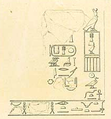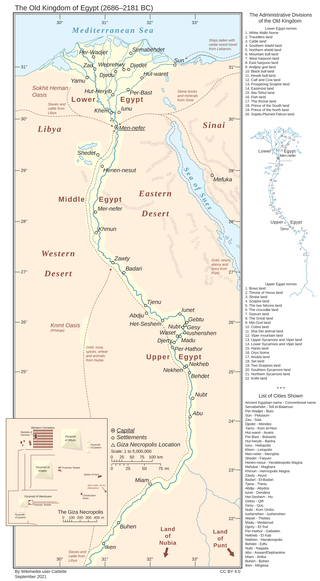
In ancient Egyptian history, the Old Kingdom is the period spanning c. 2700–2200 BC. It is also known as the "Age of the Pyramids" or the "Age of the Pyramid Builders", as it encompasses the reigns of the great pyramid-builders of the Fourth Dynasty, such as King Sneferu, who perfected the art of pyramid-building, and the kings Khufu, Khafre and Menkaure, who constructed the pyramids at Giza. Egypt attained its first sustained peak of civilization during the Old Kingdom, the first of three so-called "Kingdom" periods, which mark the high points of civilization in the lower Nile Valley.
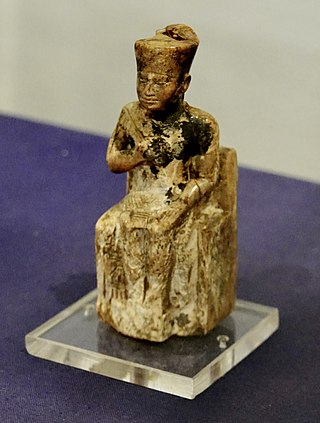
Khufu or Cheops was an ancient Egyptian monarch who was the second pharaoh of the Fourth Dynasty, in the first half of the Old Kingdom period. Khufu succeeded his father Sneferu as king. He is generally accepted as having commissioned the Great Pyramid of Giza, one of the Seven Wonders of the Ancient World, but many other aspects of his reign are poorly documented.

Sahure was a pharaoh of ancient Egypt and the second ruler of the Fifth Dynasty. He reigned for about 13 years in the early 25th century BC during the Old Kingdom Period. Sahure's reign marks the political and cultural high point of the Fifth Dynasty. He was probably the son of his predecessor Userkaf with Queen Neferhetepes II, and was in turn succeeded by his son Neferirkare Kakai.
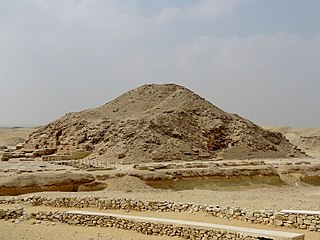
The Fifth Dynasty of ancient Egypt is often combined with Dynasties III, IV and VI under the group title the Old Kingdom. The Fifth Dynasty pharaohs reigned for approximately 150 years, from the early 25th century BC until the mid 24th century BC.

Userkaf was a pharaoh of ancient Egypt and the founder of the Fifth Dynasty. He reigned for seven to eight years in the early 25th century BC, during the Old Kingdom period. He probably belonged to a branch of the Fourth Dynasty royal family, although his parentage is uncertain; he could have been the son of Khentkaus I. He had at least one daughter and very probably a son, Sahure, with his consort Neferhetepes. This son succeeded him as pharaoh.

Menkauhor Kaiu was an Ancient Egyptian pharaoh of the Old Kingdom period. He was the seventh ruler of the Fifth Dynasty at the end of the 25th century BC or early in the 24th century BC.

Djedkare Isesi was a pharaoh, the eighth and penultimate ruler of the Fifth Dynasty of Egypt in the late 25th century to mid-24th century BC, during the Old Kingdom. Djedkare succeeded Menkauhor Kaiu and was in turn succeeded by Unas. His relationship to both of these pharaohs remain uncertain, although it is often conjectured that Unas was Djedkare's son, owing to the smooth transition between the two.

Neferefre Isi was an ancient Egyptian pharaoh of the Fifth Dynasty during the Old Kingdom period. He was most likely the eldest son of pharaoh Neferirkare Kakai and queen Khentkaus II. He was known as prince Ranefer before he ascended to the throne.
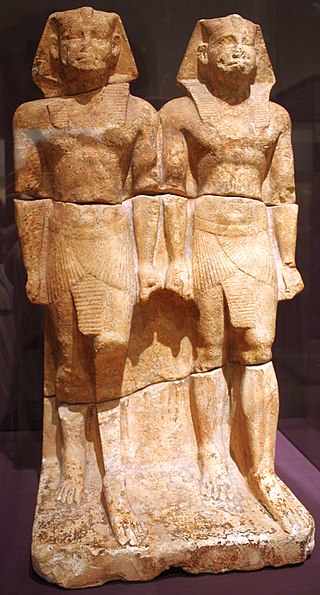
Nyuserre Ini was an Ancient Egyptian pharaoh, the sixth ruler of the Fifth Dynasty during the Old Kingdom period. He is credited with a reign of 24 to 35 years depending on the scholar, and likely lived in the second half of the 25th century BCE. Nyuserre was the younger son of Neferirkare Kakai and queen Khentkaus II, and the brother of the short-lived king Neferefre. He may have succeeded his brother directly, as indicated by much later historical sources. Alternatively, Shepseskare may have reigned between the two as advocated by Miroslav Verner, albeit only for a few weeks or months at the most. The relation of Shepseskare with Neferefre and Nyuserre remains highly uncertain. Nyuserre was in turn succeeded by Menkauhor Kaiu, who could have been his nephew and a son of Neferefre.

Shepseskare or Shepseskara was an Ancient Egyptian pharaoh, the fourth or fifth ruler of the Fifth Dynasty during the Old Kingdom period. Shepseskare lived in the mid-25th century BC and was probably the owner of an unfinished pyramid in Abusir, which was abandoned after a few weeks of work in the earliest stages of its construction.

The pyramid of Neferirkare was built for the Fifth Dynasty pharaoh Neferirkare Kakai in the 25th century BC. It was the tallest structure on the highest site at the necropolis of Abusir, found between Giza and Saqqara, and still towers over the necropolis. The pyramid is also significant because its excavation led to the discovery of the Abusir Papyri.

Egyptian sun temples were ancient Egyptian temples to the sun god Ra. The term has come to mostly designate the temples built by six or seven pharaohs of the Fifth Dynasty during the Old Kingdom period. However, sun temples would make a reappearance a thousand years later under Akhenaten in the New Kingdom with his building of the Karnak Temple in Thebes.

Al-'Ain al-Sokhna is a town in the Suez Governorate, lying on the western shore of the Red Sea's Gulf of Suez. It is situated 55 kilometres (34 mi) south of Suez and approximately 120 kilometres (75 mi) east of Cairo.
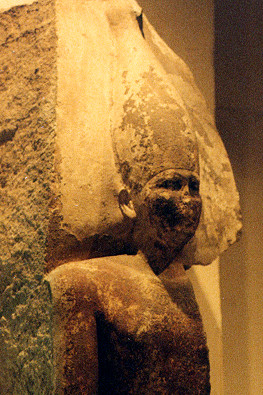
Sneferu, well known under his Hellenized name Soris, was the founding pharaoh of the Fourth Dynasty of Egypt during the Old Kingdom. Estimates of his reign vary, with for instance The Oxford History of Ancient Egypt suggesting a reign from around 2613 to 2589 BC, a reign of 24 years, while Rolf Krauss suggests a 30-year reign, and Rainer Stadelmann a 48-year reign. He built at least three pyramids that survive to this day and introduced major innovations in the design and construction of pyramids.

Meresankh IV was a queen of Egypt in the 5th Dynasty. Her name means "she loves life". While some sources consider that her husband is unknown, other sources suggest her husband was Pharaoh Menkauhor Kaiu. It is also possible that Meresankh was the wife of Djedkare Isesi.
Reptynub was a Queen during the Fifth Dynasty of Egypt. She was the wife of King Nyuserre Ini. She was possibly a mother of Menkauhor Kaiu.
The Headless Pyramid, otherwise identified as Lepsius XXIX, is the remain of a pyramid complex built in Saqqara. The identity of the pyramid owner is unclear, though it is suspected to belong to either pharaoh Menkauhor of the Fifth Dynasty or pharaoh Merikare of the Tenth Dynasty, both of whom are known to have built a pyramid. If associated with Menkauhor, the pyramid's name is Nṯr-ỉswt Mn-kꜣw-ḥr meaning 'Divine are the places of Menkauhor'; if associated with Merikare, the pyramid's name is Wꜣḏ-swt Mry-kꜣ-rꜥ meaning 'Fresh are the places of Merikare'. Other candidates for the pyramid owner that have been proposed are Amenemhat I of the Twelfth Dynasty and an ephemeral pharaoh Ity of the Eighth Dynasty.
Ptahhotep Desher was an Ancient Egyptian official at the end of the Fifth Dynasty, most likely in office under kings Menkauhor Kaiu and Djedkare Isesi. His main function was that of a vizier. This was the most important office in Ancient Egypt, second only to the king. Ptahhotep also held other titles, such as overseer of the six great houses, overseer of the scribes of the royal documents and overseer of all royal works. These are all important functions, often held by a vizier.

The pyramid of Nyuserre is a mid-25th-century BC pyramid complex built for the Egyptian pharaoh Nyuserre Ini of the Fifth Dynasty. During his reign, Nyuserre had the unfinished monuments of his father, Neferirkare Kakai, mother, Khentkaus II, and brother, Neferefre, completed, before commencing work on his personal pyramid complex. He chose a site in the Abusir necropolis between the complexes of Neferirkare and Sahure, which, restrictive in area and terrain, economized the costs of labour and material. Nyuserre was the last king to be entombed in the necropolis; his successors chose to be buried elsewhere. His monument encompasses a main pyramid, a mortuary temple, a valley temple on Abusir Lake, a causeway originally intended for Neferirkare's monument, and a cult pyramid.

The Lepsius L Pyramid is the remain of a pyramid complex built in Dahshur, approximately 250 m (820 ft) east of the Red Pyramid of pharaoh Sneferu of the Fourth Dynasty. The identity of the pyramid owner is unknown. The site was initially visited by Karl Richard Lepsius during his 1842–45 expedition to Egypt. He provided a brief description and catalogued it as 'Steinpyramide L' in his pyramid list. The site was then excavated by Rainer Stadelmann in 1986.







